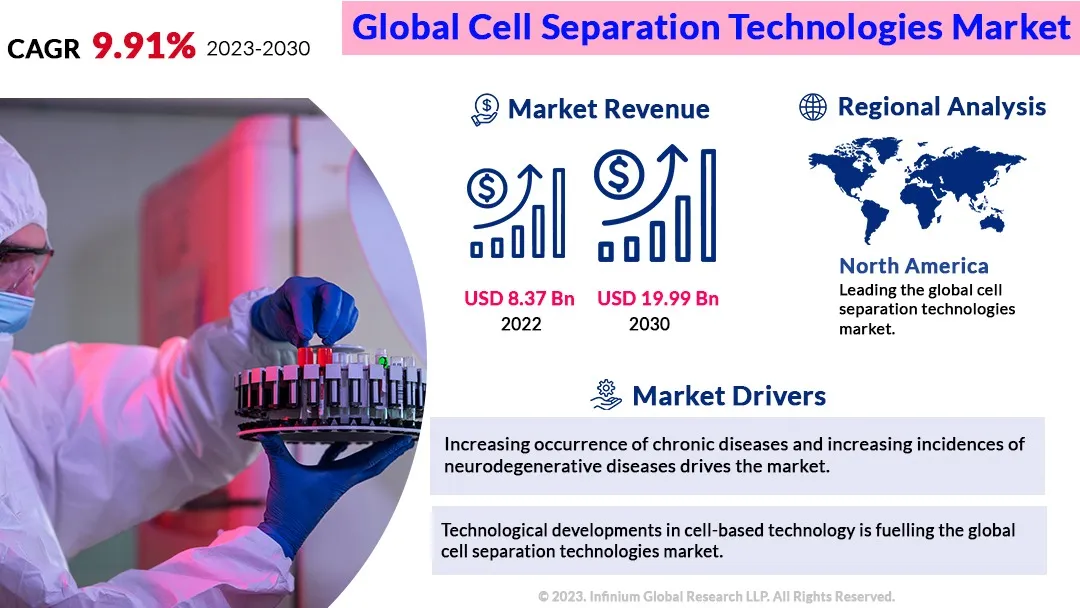Cell Separation Technologies Market (Technology - Immunomagnetic Cell Separation, Fluorescence-activated Cell Sorting, Microfluidic Cell Separation, and Others; Application - Stem Cell Research, Immunology, Cancer Research, and Others; End User - Biotechnology and Pharmaceutical Companies, Hospitals and Diagnostic Laboratories, and Others): Global Industry Analysis, Trends, Size, Share and Forecasts to 2030
A recent report published by Infinium Global Research on cell separation technologies market provides in-depth analysis of segments and sub-segments in the global as well as regional cell separation technologies market. The study also highlights the impact of drivers, restraints, and macro indicators on the global and regional cell separation technologies market over the short term as well as long term. The report is a comprehensive presentation of trends, forecast and dollar values of global cell separation technologies market.
Market Insight:
Cell separation technologies, also known as cell sorting or cell isolation, are essential tools in the field of biology and medicine. These techniques enable researchers and clinicians to separate specific types of cells from a heterogeneous mixture, such as blood, tissue samples, or cell cultures, based on various distinguishing characteristics, including size, surface markers, or physical properties. Additionally, the scope of cell separation technologies lies in advancing cancer research and therapy. By isolating and studying cancer cells, researchers can gain deeper insights into the molecular mechanisms of cancer development and progression. Additionally, cell separation plays a crucial role in personalized medicine approaches for cancer treatment. It allows for the isolation of Circulating Tumor Cells (CTCs) from a patient's blood, providing valuable information about the tumor's genetic mutations and helping clinicians tailor treatment strategies to the individual patient's needs. Furthermore, the isolation of specific immune cell populations using these technologies is instrumental in developing immunotherapies, which harness the body's own immune system to target and eliminate cancer cells. Overall, cell separation technologies hold significant promise in revolutionizing cancer diagnosis and treatment, ultimately improving patient outcomes.
The increasing occurrence of chronic diseases and increasing incidences of neurodegenerative diseases are the major factors that drive the growth of the global cell separation technologies market across the globe. Growth in cell therapy-based research activities and growth in government spending in the biotechnology area are the other factors that fuel the growth of the market. Furthermore, technological developments in cell-based technology such as cell isolations, time and cost-effectiveness also fuel the global cell separation market during the forecast period. However, the lack of skilled healthcare professionals and regulatory issues may hamper the growth of the global cell separation technologies market. Moreover, the rising demand for stem cells in stem cell therapy creates an opportunity for the growth of the global cell separation technologies market in the next few years.

North America is leading the global cell separation technologies market and is expected to hold the largest market shares in the global market during the forecast period. This is attributed to improved research infrastructure. Also, the rise in government funding in the life science arena fuels the growth of the market in the North America region. The Asia-Pacific is anticipated to witness the fastest growth during the forecast period due to increasing awareness of chronic diseases and growth in government initiatives to improve cell-based technology. Improving healthcare infrastructure also boosts the growth of the market in the Asia-Pacific region. India and China are projected to be the fastest-growing cell separation technologies markets in the Asia-Pacific region.
Report Scope of the Cell Separation Technologies Market:
| Report Coverage | Details |
|---|---|
| Market Size in 2022 | USD 8.37 Billion |
| Market Size by 2030 | USD 19.99 Billion |
| Growth Rate from 2023 to 2030 | CAGR of 9.91% |
| Largest Market | North America |
| No. of Pages | 255 |
| Market Drivers |
|
| Market Segmentation | By Technology, By Application, and By End User |
| Regional Scope | North America, Europe, Asia Pacific, and RoW |
Segment wise revenue contribution in the global cell separation technologies market
The report on global cell separation technologies market provides a detailed analysis of segments in the market based on Technology, Application, and End User.
Segmentation Based on Technology
· Immunomagnetic Cell Separation
· Fluorescence-activated Cell Sorting
· Microfluidic Cell Separation
· Others
Segmentation Based on Application
· Stem Cell Research
· Immunology
· Cancer Research
· Others
Segmentation Based on End User
· Biotechnology and Pharmaceutical Companies
· Hospitals and Diagnostic Laboratories
· Others
Company Profiled:
· Terumo BCT, Inc.
· STEMCELL Technologies
· Merck KGaA
· Thermo Fisher Scientific Inc.
· BD
· DH Life Sciences, LLC.
· Bio-Rad Laboratories, Inc.
· GenScript
· Miltenyi Biotec
· Others
Report Highlights:
The report provides deep insights into demand forecasts, market trends, and micro and macro indicators. In addition, this report provides insights into the factors that are driving and restraining the growth in this market. Moreover, The IGR-Growth Matrix analysis given in the report brings an insight into the investment areas that existing or new market players can consider. The report provides insights into the market using analytical tools such as Porter's five forces analysis and DRO analysis of the cell separation technologies market. Moreover, the study highlights current market trends and provides forecasts from 2023-2030. We also have highlighted future trends in the market that will affect the demand during the forecast period. Moreover, the competitive analysis given in each regional market brings an insight into the market share of the leading players.
